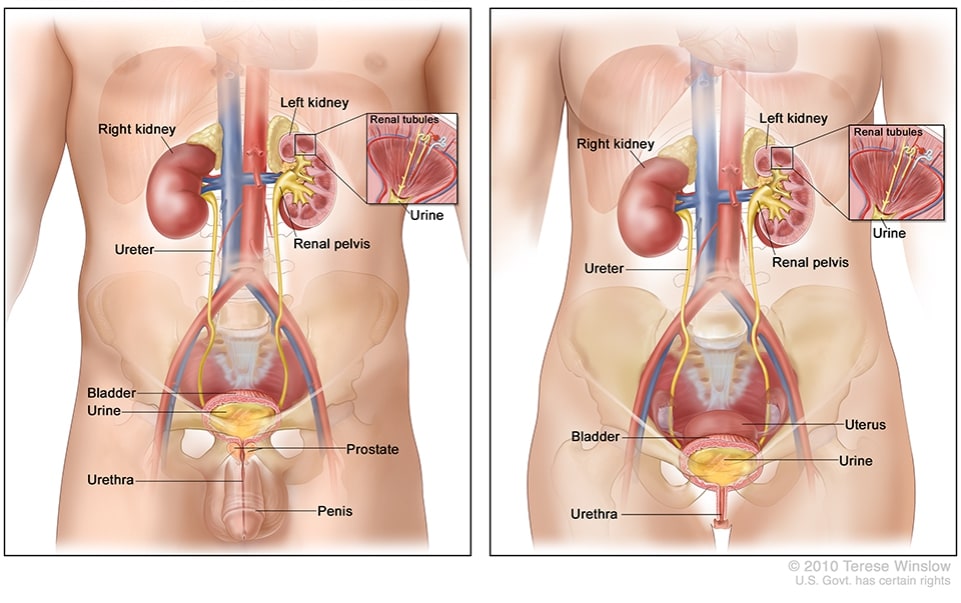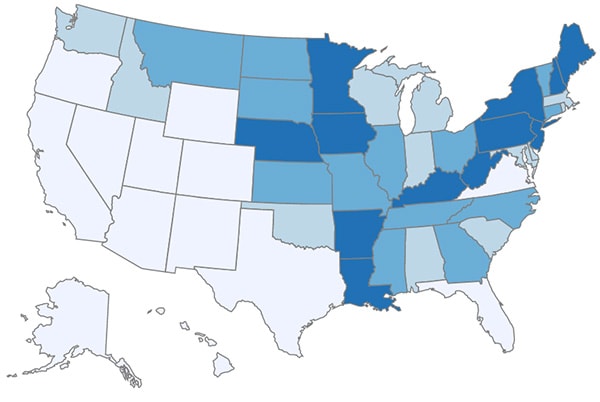Bladder Cancer

Anatomy of the male urinary system (left panel) and female urinary system (right panel); two-panel drawing showing the right and left kidneys, the ureters, the bladder filled with urine, and the urethra. The inside of the left kidney shows the renal pelvis. An inset shows the renal tubules and urine. Also shown are the prostate and penis (left panel) and the uterus (right panel).
© 2010 Terese Winslow LLC, U.S. Govt. has certain rights. Used with Permission. Contact artist at www.teresewinslow.com for licensing.
Cancer is a disease in which cells in the body grow out of control. When cancer starts in the bladder, it is called bladder cancer.
To lower the risk of bladder cancer, don’t smoke and be especially careful around certain kinds of chemicals.
What Is the Bladder?
The bladder (sometimes called the urinary bladder) is a balloon-shaped organ in your lower abdomen, near the pelvis. It stores urine from the kidneys until it is passed out of the body.
What Are the Symptoms of Bladder Cancer?
- Blood in the urine. This is the most common symptom.
- Having to urinate often.
- Pain while urinating.
- Back pain.
- Pelvic pain.
These symptoms can also come from other conditions. If you have any of them, talk to your doctor, which is the only way to find out what may be causing them.
What Causes Bladder Cancer?
Smoking is the most important risk factor for bladder cancer. Other risk factors include—
- Having a family history of bladder cancer.
- Having certain gene mutations (unusual changes made when your body’s cells are dividing).
- Being exposed to too much of certain workplace chemicals [PDF-4.7MB] used in processing paint, dye, metal, and petroleum products.
- Taking some kinds of chemotherapy drugs.
- Drinking well water contaminated with arsenic.
- Taking the Chinese herb Aristolochia fangchi.
- Having chronic urinary tract infections (including those caused by Schistosoma haematobium).
How Can I Reduce My Risk for Bladder Cancer?
To lower the risk of bladder cancer, don’t smoke (and if you do, quit) and be especially careful around certain kinds of chemicals.
Statistics
The Data Visualizations tool makes it easy for anyone to explore and use the latest official federal government cancer data from United States Cancer Statistics. It includes the latest cancer data covering the U.S. population.
- Bladder Cancer (National Cancer Institute)
- Bladder Cancer (American Cancer Society)
- Tobacco and Cancer (CDC)
- Chemicals, Cancer, and You [PDF-4.7MB] (Agency for Toxic Substances and Disease Registry)
- Cancer-Causing Substances in the Environment (National Cancer Institute)


